Introduction
In these series of articles on vaccines I would like to spend some time on how vaccines work with the immune system so you can appreciate how complex the generation of vaccine mediated response is and how critical it is that vaccinated infants, young children and even adults possess a healthy immune system to protect themselves from not only the infectious disease but the potential adverse effects from the vaccine itself.
The Immune System
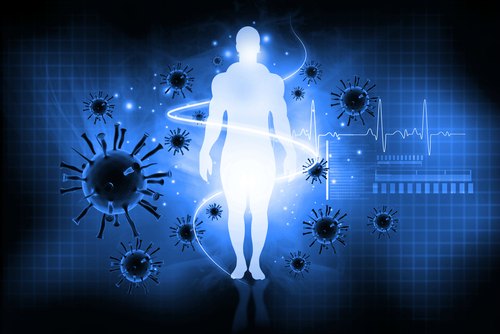
Adaptive-Innate Immune response
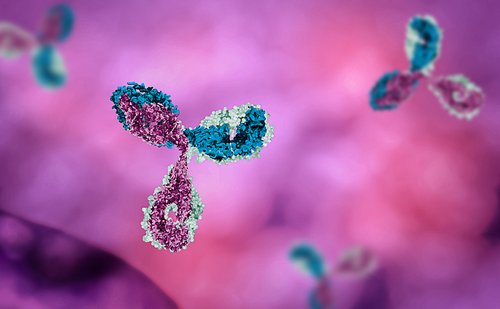
The immune system is a remarkable biological marvel, complex but effective in a healthy gut. When people are discussing vaccines they always refer to ‘anti-bodies’ which are the proteins required to deal with the ‘antigens’ that are introduced to the body via the vaccine. A specific response that leads to the production of Anti-bodies is known as the Adaptive Immune response (also known as Humoral immunity because body fluids were once referred to as Humors) since it represents a lifetime adaptation to infection with a many pathogens, synonymous to a lifelong protective immunity. However not all adaptive immune response entails anti-body production. The immune system also has the capability to destroy pathogenic invaders using the voracious phagocytic cell the macrophage without prior exposure, which is a key component of the Innate Immune response. Both responses involve the recruitment of a variety of white blood cells or Leukocytes and the Adaptive immune response depend upon Lymphocytes that provide the lifetime immunity, that can follow from an infection or a vaccine. In essence both systems work in synergy through a unique pathway called the Toll pathway which is initially used at the instance an invader is sensed when the Innate Immune system signals the Adaptive Immune system that an invasion has begun.
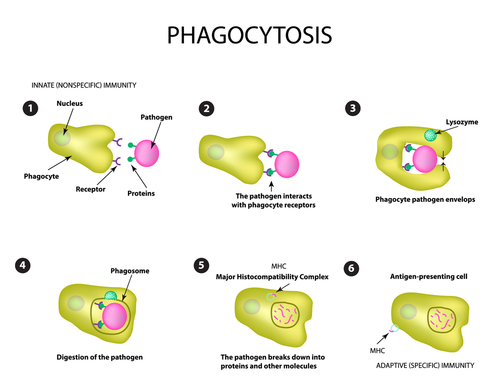
So the first line of defense in response to a foreign invader into the body (such as a vaccine) is the activation of the Innate immune response where the infectious agent is recognized by preformed non-specific effectors in the form of Phagocytes (Macrophages) and Complements**. The bacterial molecules that become bound to the surface receptors of the macrophage triggers the macrophage to engulf the invader, in turn cytokines (type of hormone signaling) are secreted by the macrophage to invite other Immune system ‘soldiers’ such as Neutrophil phagocytes the vacuum cleaners of the IS to the ‘infection party’. It is the cytokine secretion that activates inflammation. The Innate response provides a critical activation step for adaptive immunity since the inflammatory response initiated by the innate immune subsystem increases the flow of lymph fluid containing antigen and antigen bearing cells into the lymphoid tissue, and in turn activates the specific antigen T lymphocytes. Then the process of adaptive response begins. Innate immunity occurs within 0-4 hours, while early induced response is usually 4-96 hours and finally Adaptive immune response is >96 hours.
** An earlier sub system of the Immune system proper that was discovered using heat-labile (substances like proteins is one that can be changed or destroyed at high temperatures) protein components of normal plasma that augmented the opsonization (The target cell is coated in Opsonin proteins (Greek word for ‘prepare to be eaten’) process, where the cell is marked for death by the macrophage. This additional defense mechanism ‘Complements’ the anti-bacterial activity of the anti-body and can be initiated early in the infection stage and is said to have evolved as part of the innate immune system. These complement proteins are inactivated proteases enzymes (Zymogens, as in the pancreas ) that are activated by proteolytic cleavage ( the breaking down of proteins into amino acids ) and were first found in the gut. These zymogens are widely distributed in the body and are ready to go to work when activated by a ‘trigger-enzyme cascade’ ( as is the case in blood coagulation that was discussed in a previous article) triggering a series of potent inflammatory events, which use 3 distinct pathways ( 3 methods of defense), the explanation of which is beyond the scope of this article. Complement activation is largely confined to the surface on which it is initiated.
White blood cell types – Soldiers of the Immune system
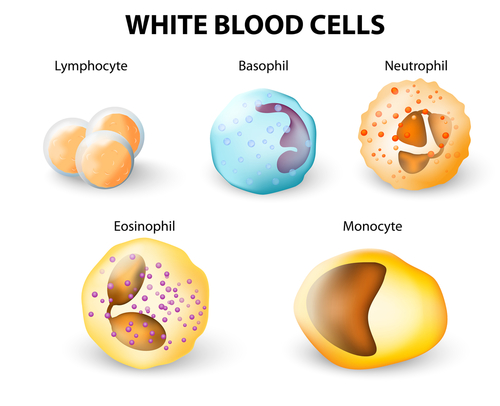
It is the bone marrow that births the immune system cells (White blood cells or hematopoietic stem cells )which then migrate to various peripheral tissues, circulate in the blood and winds its way through a unique system of vessels called the lymphatic system. Two specialized cells T & B cells circulate between the blood and the peripheral lymphoid tissues, where the B cells differentiate into anti-body secreting cells and the T cells differentiate into effector T cells with a variety of functions. Other immune system leukocytes include monocytes, Dendritic cells, basophils,eosinophils and neutrophils which circulate in the blood and only enter the tissues when an infection or inflammation occurs. Eosinophils and Neutrophils are activated in response to an allergic reaction and fending off parasites. Dendritic cells enter peripheral tissue to ingest antigens which are then used to activate antigen specific T cells. Monocytes enter tissue where they differentiate into macrophages. The T & B cells are known as lymphocytes, where the T Cell Lymphocyte differentiates into 2 types, a Cytotoxic T cell that kills cells infected with viruses, and T cells that activate B cells and macrophages. These cells are heavily disguised as small simple inactive cells but when the time arrives they spring into action like something out of a Marvel comic. ( B cells differentiate in the Bone marrow, but the T cells differentiate in the Thymus).
The Antigen Trap – The lymph system
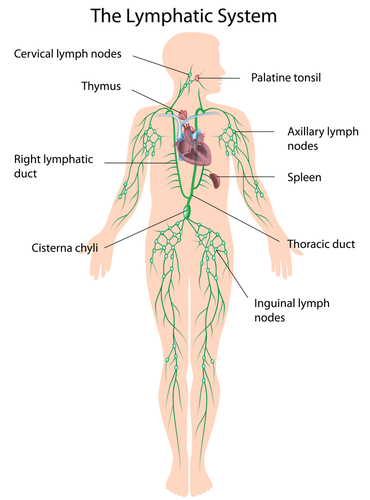
The lymphatic system (Lymph nodes, spleen, mucosal lymphoid tissue) is a surveillance circulatory system like a security net, where the various security lymphocytes are ‘guarding’ the body looking for pathogens that have set up camp anywhere in the body. The lymph system is a type of highly organized drainage system collecting extra cellular fluid continuously from the tissues and returning it to the blood. It is this circulatory system that transports antigen bearing cells ( the dendritic cells) and antigens from infected tissues to the lymph nodes where they become imprisoned.
The Lymphocyte Receptor Repertoire
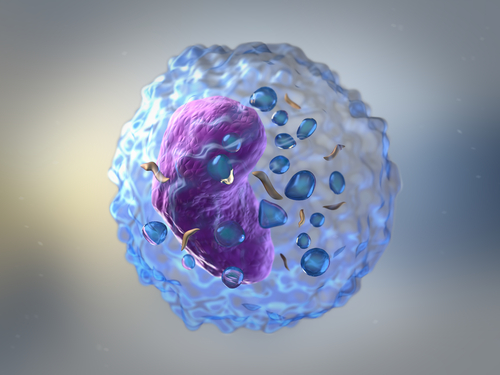
Since foreign substance laden vaccines are introduced into the body it is interesting to note the response of the defensive immune system. The Innate immune response system is effective in dealing with many pathogens, but it lacks the sophisticated surveillance necessary to recognize infectious agents that disguise their surface molecule identifiers common to many pathogens. Many bacteria and pathogens have the ability to ‘cloak’ themselves to escape detection. Viruses for example possess these ‘cloaking’ devices. However the adaptive side of our defense system contains a recognition mechanism enabling it to ‘de-cloak’ these invaders with an almost infinite diversity of antigens targeting each specific pathogen. Although each lymphocyte carries antigen receptors of only one specificity, enabling the body to create millions of lymphocytes carrying their own specific antigen receptor ( this is referred to as the Lymphocyte receptor repertoire that exists in each individual)..I know what you’re thinking….Wow.
Lymphocyte Regulation
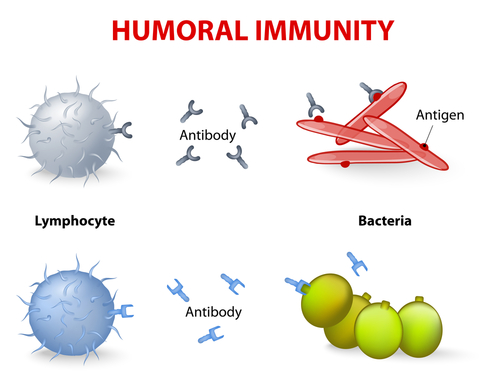
This is all part of the lifetime immunity mechanism, so when an antigen is bound to a receptor, the lymphocyte is activated to divide and produce many clones which secrete clonotypic antibodies with a specificity identical to the surface receptor that first triggered activation and clonal expansion. The big question is how does the body prevent lymphocytes from recognizing antigens on the tissues of the body and attacking as in autoimmune conditions? I will answer this question in the section Autoimmune disease. The millions of specific antigen lymphocytes are generated by a distinct somatic gene rearrangement which are randomly joined to others by an irreversible process of DNA recombination. This is a truly remarkable mechanism to maintain the percentage of B and T cells constant and how the most useful receptor specificity is selected. Apoptosis also occurs in the lymphocyte family as in all cells, since each day the bone marrow produces many millions of new lymphocytes, but the renewal process is unique because of the specificity associated with each lymphocyte..I know…wow. So with all this going on..lymphocyte renewal..clonal expansion..antigen activated naive lymphocytes into lymphoblasts that clone themselves into a 1000 daughter cells within 3-5 days is the reason that it takes 4-7 days for the activation of adaptive immunity to be completed.
When a vaccine is administered for the first time the primary response in time lags (encounters very little specific antibody in the serum). After the time lag (4-5 hours) the antibody against the antigen appears that rises to a plateau and then declines within an approximate 24 hour period. Upon administering the antigen again a secondary response is very rapid and intense demonstrating immunological memory, which is the reason booster shots are given for some vaccines.
Pathogenic Points of Entry

If you have read my article on the Microbiome and the immune system you probably have an idea how the immune system works and the various protective cells that are recruited to accomplish the body’s defense against foreign substances. This explanation was based on natural immunity where foreign substances are ingested orally through the GI Tract, however vaccines are administered intravenously directly into the bloodstream, but since we have a very efficient security circulatory system (Lymph system) as explained above it makes little difference. Polio and Rotavirus are gut pathogens so there preferred port of entry would be the mouth/gut route, while Diphtheria,whooping cough, influenza, measles and chickenpox prefer the mouth/respiratory routes while tetanus,rabies prefer entry through the skin. So injecting a vaccine into the muscle tissue causes the ‘antigens’ (or foreign substance)to attract immune cells such as dendritic cells, and 2 types of White blood cell Leukocytes: monocytes and Neutrophils.
Cell Mediated Response
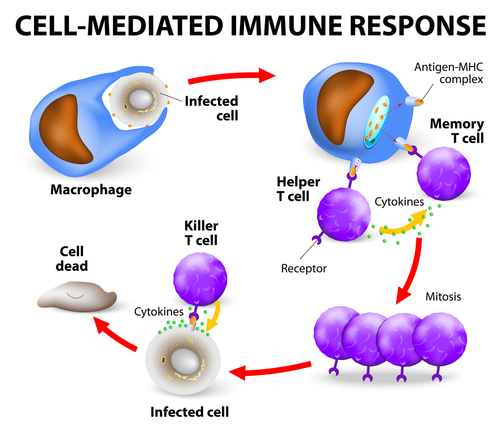
People talk about cell mediated response or TH1. Anti-bodies can flush out pathogens that have set up shop in the blood and the extra-cellular spaces, but some bacteria and all viruses hide inside our own mammalian cells to replicate but they are hidden from anti-bodies. However specific T lymphocytes called cytotoxic T cells as mentioned earlier, have the ability to destroy virus infected cells using activated enzymes called ‘Caspases’. The replicating virus eventually kills the cell, releasing virus particles which are displayed on the surface of the cell which is identified by the cytotoxic T Cell.
Auto-immune conditions
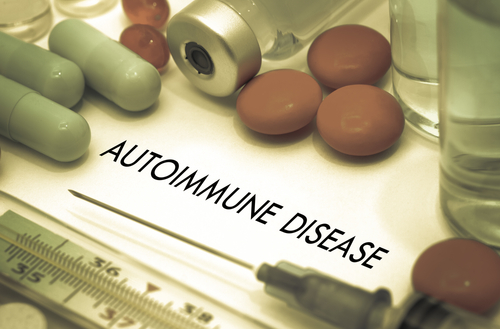
You may have heard that vaccines can cause auto-immune disease, well unless the vaccine creates a catastrophic failure in the immune system, which occurs with the administration of anti-biotics and immunosuppressive drugs (which inhibit the functioning of the total lymphocyte population thus killing the immune system), then in my opinion it would be rare. Injecting multiple doses of vaccine viruses within the same day in an already compromised immune system then it might be possible. The key is to maintain immune system integrity. To understand other ways of autoimmune conditions to occur I would like to reprint here a paragraph that I wrote in the article ‘Microbiome and disease Part 2 which states :
The WnT Pathway and regulation of TJ cell replacement
We know that cell proliferation and differentiation (I use this term because stem cells are virgin undifferentiated cells until the body produces specific differentiated cells for particular organs or tissue) relies on a series of feedback loops involved in a pathway referred to as the Wnt Pathway that balances the opposing processes of proliferation and differentiation. This pathway is regulatory and in this context it is ‘Canonical’ (a calculated order of events ) and the coordinated timing between the shedding of an old cell and the replacement of the new cell is crucial, while maintaining epithelial integrity at all times. This is a highly ingenious design and its like repairing the walls of our medieval castle while it’s being sieged. If this replacement process is compromised this could be a way in through the tight junctions of the gut barrier. It has also been suggested by Biochemical scientist Colston that a deficiency (caused by Toxic ingestion) in Calcitriol (the active form of Vitamin D3 (1,25 dihydroxyvitamin D3) disrupts the elegant enterocyte replacement cycle leading to a depleted enterocyte renewal causing excess wearing of the brush borders leading to Celiac disease. Furthermore, Calcitriol deficiency can also lead to a deficiency or complete absence of Heparin Sulphate potentially causing Colitis and Crohn’s disease. Colston wrote : ‘ Taken together these findings suggest that the major function of calcitriol on the small intestine is to promote differentiation of immature enterocytes in the crypts and at the base of the villi’.
The basic reason for auto-immune conditions to erupt is that the immune system becomes unbalanced where commensal flora is allowed to overgrow releasing themselves from the control of the beneficial flora. If this is allowed to occur then the commensal or pathogenic flora are allowed to secrete their toxins and in the worst case scenario the pathogenic flora also have the ability to breach the tight junction security gate within the epithelium allowing pathogens and toxins to get inside the body, the bloodstream, and across the blood brain barrier into the brain, and again reprinting the specific paragraph on toxins taken from the same article:
Causes of Epithelial Breach -Toxins
Despite the bodies considerable efforts to maintain barrier integrity it can be breached. The ingestion of NSAID (Nonsteroidal anti-inflammatory drug) such as Indomethacin,, Aspirin and others do their best to destroy one barrier maintenance task by inhibiting Prostaglandin synthesis. Gastrointestinal infection from parasites such as Cryptosporidium Parvum, and Toxins secreted from Bacteroides Fragilis also put pressure on wall integrity. One of the protein families that are part of the tight junction membrane are called Claudins and it is known that specifically Claudin 3 and 4 are potential targets for Clostridia toxins (Perfringens enterotoxin) that bind to the Claudin 3/4 proteins increasing tight junction permeability. As we mentioned above, the Epithelial Tight junctions (TJ) allow some substances in and bar the passage of others so the TJ are fairly dynamic insofar as they are opening and closing all of the time to a variety of cellular pathways that can potentially be usurped by pathogens. One of these pathways concern the ‘Zonulin’ pathway which bacteria such as Vibrio Cholerae exploit by secreting a variety of toxins including ‘Zonula Occludens’ (an enterotoxin). This toxin binds to the apical membrane receptors on the enterocyte creating an intracellular pathway increasing TJ permeability to the extent of a gut barrier breach. You may remember the article ‘Microbiome and the Immune system’ where we discussed the Inflammation first responders, the voracious phagocyte the Neutrophil. During a less serious inflammatory response like getting a cold Neutrophil activity across the gut barrier is not a problem. However, a more serious inflammatory response, especially if it is not quelled, and is continuous, neutrophils have virtually VIP access around the body except for the central nervous system,brain and the spinal cord which are super high security areas. When a neutrophil ‘army’ impale the tight junctions crossing the gut barrier they potentially induce significant damage to barrier function. Toxic food, drugs and stress can all have the same effect (You can read more in the referenced previous article on the Microbiome).
What’s more if the gut is dysbiotic (unbalanced ) this will affect the immune system which also becomes confused and compromised so it loses its regulated function and then we have ‘CHAOS’. Furthermore in my second article on the Cancer series of articles I mentioned another critical fact involving a unique identifier present in all Mammalian cells MHC:
All human mammalian cells contain a unique identifier ‘fingerprint’ which is expressed in the cell membrane in the form of an antigen protein referred to as ‘ Major Histocompatibility Complex’ (MHC). It is this ID marker that is read by our immune system to distinguish self from invader. In autoimmune diseases (Hashimoto’s disease, Psoriasis, etc ) is caused by microbiota imbalance. Since the Immune system is malfunctioning, it inhibits, or is incapable of reading the MHC ‘fingerprints’, so the immune system begins to attack the host tissue mistakenly thinking that they are foreign tissue.
Vaccination/Immunization
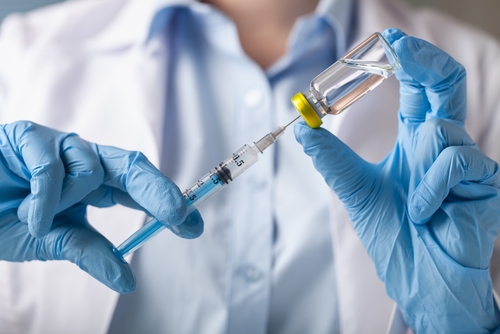
The deliberate stimulation of the Immune system via vaccination is actually Immunization. To induce the Immune system to elicit a protective response against pathogenic microorganisms is referred to as vaccination, but this term only applies to immune response to smallpox when immunizing with the cross reactive (binding of an antigen to an anti-body) cowpox virus Vaccinia. To determine adequate immune function, analysis of serum (antiserum in this case because it should contain anti-bodies against the antigen introduced into the body) taken from an individual is done. Some Immunogenic proteins ( that can induce an immune response) such as ‘Killed’ virus material are not strong enough to elicit a response, so a stimulant (adjuvant) is attached to a protein. Adjuvants include Freund`s adjuvant which is a mixture of oil in water emulsion with dead mycobacteria or Aluminium hydroxide gel. Immune Stimulatory Complexes (ICOS) are lipid layers that contain protein antigens with detergent and a saponin glycosides (used in Liquorice for example) e.g Quil A which is isolated from the bark of a soap bark tree (Quillaja saponaria) an evergreen found in Chile. This ICOS combination tends to fuse with the plasma membrane allowing the antigen to be delivered within intracellular space, the cytosol where it can induce a cell mediated immune response. Vaccines like HIV and hepatitis B use this mechanism.
Pathogenic/Host Battles
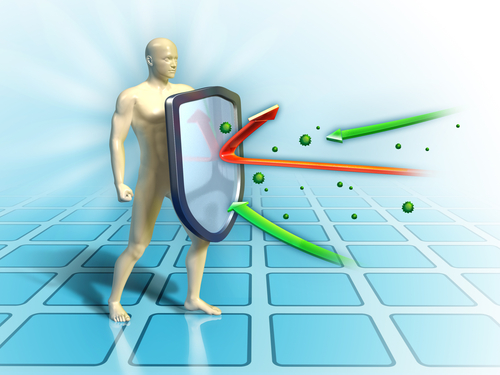
It is important that as you go about your normal business every day, inside your body battles rage between pathogenic micro-organisms and your immune system. It is important that your immune system is maintained and battle ready 24/7.Can you imagine if you consciously had to work out battle strategies to fight these microbes and as a General orchestrate plans to defeat the enemy at the gates and also to manually regulate biological functions as does the autonomic nervous system. Your life would be short lived. Luckily our wonderful self–regulating body does all of this automatically and all it wants in return are a few nutrients to keep the pistons greased, and clean fuel to keep the fires burning. Our immune system requires constant updates to destroy invaders that want to harm us, not out of revenge but to survive themselves.
Viruses have intelligence as well-known
There are many viruses that produce proteins that interfere with our host defenses. In response to a viral attack many cells produce cytokines IFN-Alpha and Beta Interferons to trigger epigenetically, genes that encode proteins to limit viral replication and directing immune response to nearby non-infected cells. Viruses such as Epstein-Barr and Adenovirus have the capability to block these signals setting up their own lines of defense. Many viruses can evade the `Complement`system as described above, as in the Vaccinia virus (smallpox/cowpox virus) that produce proteins that bind to the C4 Complement component inhibiting connection to the signaling recognition pathway (Toll pathway) of the overall system instigated by antibody-antigen (Ab-Ag) complexes to the other effector proteins of the innate immune response. Some viruses can constantly change their antigen profiles in an attempt to avoid attack, and good example of this is the influenza virus that despite annual inoculation of a Flu vaccine most of the time it does not work and people still became sick, probably because the Influenza virus is constantly changing its antigen profile, by creating many different strains.
Antigenic variation in the rhinovirus has affected vaccine production for the common cold. The `maestro`in antigenic variation is the HIV virus that accumulate mutations at a rate 65 times faster than Influenza. Cytotoxic T lymphocytes that are responsible for the destruction of virus infected cells can be temporarily stopped in their tracks` by pathogens that are capable of removing identifying molecules from the cell surface of the infected cells (called elimination of surface class 1 expression) that become invisible to the Cytotoxic T lymphocytes, allowing the virus to proliferate. The measles virus can inhibit IL12 Interferon (involved with T cell differentiation) production by monocytes causing general immunosuppression of a cell mediated response. The pox virus is capable of inhibiting apoptosis of parasite infected cells that should be destroyed by CTL`s (Cytotoxic T lymphocytes) and NK (Natural killer cells). Vaccines need to be effective against these pathogenic onslaughts by `training the immune system`, as a mean of protection.
Conclusions
I apologize for the deep science in this article but it’s necessary to get a basic grasp of how the immune system operates and to appreciate its complexity and its various functional subsystems. The purpose of which is to understand what the various teams of virologists and immunologists and others need to understand in developing vaccines and as we will discover they are far from perfect. Even the authors of the 1989 publication ìmmunological adjuvants and vaccines wrote “While there is no question about the efficacy of such vaccines and their safety in the great majority of recipients, vaccines can produce encephalitis or other complications in humans with Immunodeficiency“. One author did work at Wakefields old hospital The Royal Free and another author at the time the book was published worked for Smithkline so I suppose they ended up looking for new careers…lol.
We have discussed the main sections of the immune system I.e The Innate Immune, The adaptive Immune, and the Complement Immune sub-systems and how they interact functionally. The Immune system soldiers (security guards) who operate within the Antigen Trap-the lymph system, providing the inner workings of the immune system, while regulatory systems within the immune system maintain sufficient numbers within the `regiments`, replacing the fallen after a pathogenic attack. We have discussed the war and battles that rage within us all every day of our lives while the immune system is designed to protect us and an appreciation of how cunning some bacterial/viral pathogens can be. Finally, we have introduced the concept of vaccination/immunization which we will continue with in Vaccines and the Immune System Part II
“I shall endeavour still further to prosecute this inquiry, an inquiry I trust not merely speculative, but of sufficient moment to inspire the pleasing hope of its becoming essentially beneficial to mankind“.
“While the vaccine discovery was progressive, the joy I felt at the prospect before me of being the instrument destined to take away from the world one of its greatest calamities [smallpox], blended with the fond hope of enjoying independence and domestic peace and happiness, was often so excessive that, in pursuing my favourite subject among the meadows, I have sometimes found myself in a kind of reverie.”
-Edward Jenner

References/Acknowledgments:
- Vaxplanations: Experiences with Dr Sheri Tenpenny on Facebook Aug 2015
- An introduction to Immunology C.Vaman Rao 2003 Book
- Immunological adjuvants & Vaccines G.Gregoriadis, A.Allison and G.Poste Book 1989
- Quillaja Saponaria, Glycoside, Vaccinia Wikipedia
- Vaccine adjuvants: putting innate immunity to work R.Coffman, A.Sher, R.Seder 2015 NCBI
- Microbiome and disease Part II article 2017 E.Malouin
- Vaccine Excipient & Media Summary Vaccine Package inserts FDA Feb 2017
Author: Eric Malouin